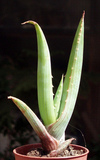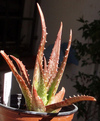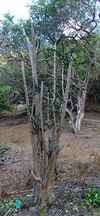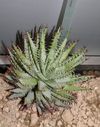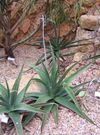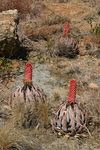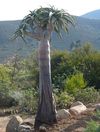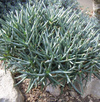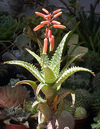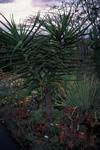Genus Aloe
Aloe is genus containing about four hundred species of flowering succulent plants.Species in the genus Aloe of plants
Clanwilliam aloe - Aloe comosa is the botanical name for what is commonly known as Clanwilliam aloe. Although Aloe comosa has always been a part of the genus Aloe, in the past it has been classified as being part of two different families: the Aloaceae or the Liliaceae family. It wasn’t until 2003 that the APG II system placed the genus in the family Asphodelaceae, however some sources still classify aloe in either of the former families.
Namibian Partridge Breast Aloe - Aloe dinteri is a species of plant in the genus Aloe. It is endemic to Namibia. Its natural habitats are subtropical or tropical dry shrubland, subtropical or tropical dry lowland grassland, and rocky areas.
Aloe eminens - Aloe eminens is a species of plant in the genus Aloe. It is endemic to Somalia, and is threatened by habitat loss.
Aloe erinacea - Aloe melanacantha var. erinacea GD.
Aloe helenae - Aloe helenae is a species of plant in in the genus Aloe. It is endemic to Madagascar.
Namaqua aloe - Aloe khamiesensis is a species of plant in the genus Aloe. It is endemic to South Africa.
Aloe kilifiensis - Aloe kilifiensis is a species of plant found on the shores around the Kenyan - Tanzanian border. Threatened by the destruction of its habitat by agriculture, it is also collected because of its flower's unique colors.
Aloe peglerae - This species occurs along the northern dip slopes of the Magaliesberg and the Witwatersberg, the range just south and parallel to it. The species is named after Alice Marguerite Pegler , a botanist and naturalist who collected at first around Kentani, and later in the vicinity of Johannesburg and Rustenburg. Her failing eyesight and health led her to confine her attention to algae and fungi. She was paid the exceptional honour of being made a member of the Linnaean Society.
Bastard quiver tree - This aloe grows up to 15 meters in height. Slightly similar to Aloe dichotoma - to which it is closely related - it can nonetheless easily be distinguished by the way that its inflorescences hang from below the lowest leaves, rather than growing erect. It also has fewer and more erect branches than its relative. Aloe pillansii, Aloe dichotoma and Aloe ramosissima are usually grouped together as the "Draco-aloe" subsection of the Aloe genus. Like its two close relatives, Aloe pillansii is found around the border between Namibia and South Africa, where its natural habitat is dry subtropical or tropical shrubland. It is severely threatened by habitat loss.
Maiden's quiver tree - This aloe is closely related to the larger, tree-like aloes Aloe dichotoma and Aloe pillansii, with which it is included in the "Draco-aloe" sub-section of the Aloe genus. Like its two close relative, it exhibits conspicuous dichotomous branching and inhabits the arid Richtersveld region around the border of South Africa and Namibia. However, Aloe ramosissima is considerably smaller - rarely reaching more than 2 meters in height - and assumes a more shrub-like shape.
Aloe sladeniana - Aloe sladeniana is a species of plant in the genus Aloe. It is endemic to Namibia. Its natural habitats are dry savanna and subtropical or tropical dry shrubland.
Aloe squarrosa - Aloe squarrosa is a species of plant in the genus Aloe. It is endemic to Yemen. Its natural habitat is rocky areas. It is visual similar to aloe juvenna.
Aloe suzannae - Aloe suzannae is a species of plant in the genus Aloe. It is endemic to Madagascar.
Aloe viridiflora - Aloe viridiflora is a species of plant in the genus Aloe. It is endemic to Namibia. Its natural habitats are dry savanna, subtropical or tropical dry shrubland, and rocky areas. It can produce hallucinations when ingested, leading to its occasional use in shamanic rituals.

